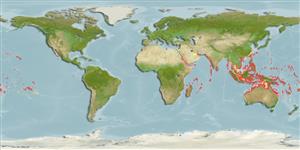Common names from other countries
Classification / Names / Names
Nomi Comuni | Sinonimi | Catalog of Fishes (gen., sp.) | ITIS | CoL | WoRMS
Environment: milieu / climate zone / depth range / distribution range
Ecologia
Associati a barriera corallina; distribuzione batimetrica 0 - 40 m (Ref. 848). Tropical; 28°N - 34°S, 26°E - 108°W (Ref. 848)
Indo-Pacific: Red Sea and eastern Africa, east to Easter Island, north to Ryukyu Islands, south to New Caledonia.
Length at first maturity / Size / Peso / Age
Maturity: Lm ? range ? - ? cm
Formation: spherical, columnar, hillocky or flat, may be several meters across. Corallites: evenly disturbed, conical, with thick walls and small openings. Costae: equal, well developed. Adjacent corallites do not join. A crown of paliform lobes often distinct. Uniform brown or green (Ref. 848).
Found in shallow reef environments with strong water movement (Ref. 848). In subtidal rock, rocky reefs, outer reef channel, back and foreslopes as well as lagoons (Ref. 98471).
Life cycle and mating behavior
Maturità | Riproduzione | Deposizione | Uova | Fecundity | Larve
Hermaphroditic (Ref. 113712). Mature gametes are shed into the coelenteron and spawned through the mouth. Life cycle: The zygote develops into a planktonic planula larva. Metamorphosis begins with early morphogenesis of tentacles, septa and pharynx before larval settlement on the aboral end (Ref. 833).
Ross, M.A. and G. Hodgson. 1981. (Ref. 8294)
IUCN Red List Status (Ref. 130435)
CITES status (Ref. 108899)
Not Evaluated
Human uses
| FishSource |
Strumenti
Fonti Internet
Estimates based on models
Preferred temperature
(Ref.
115969): 24.6 - 29, mean 28 (based on 886 cells).
Price category
Unknown.
